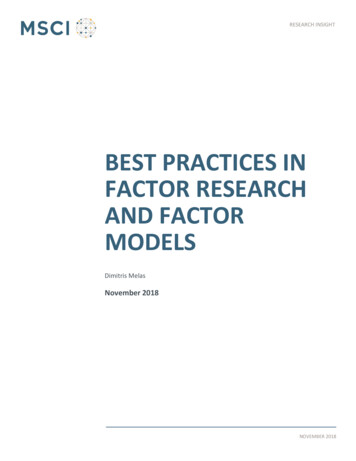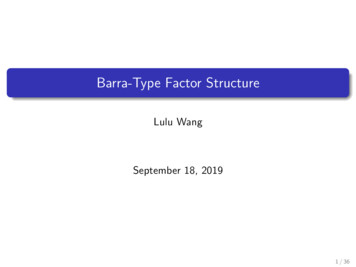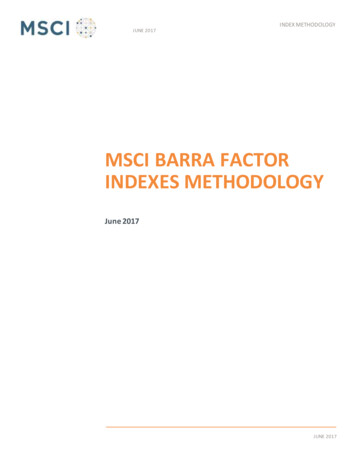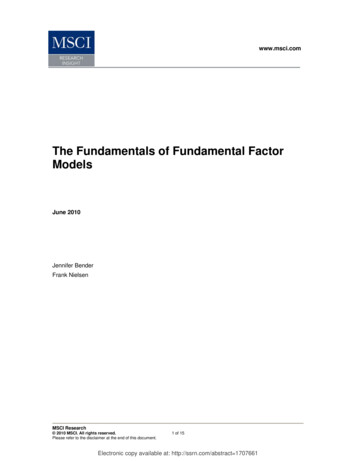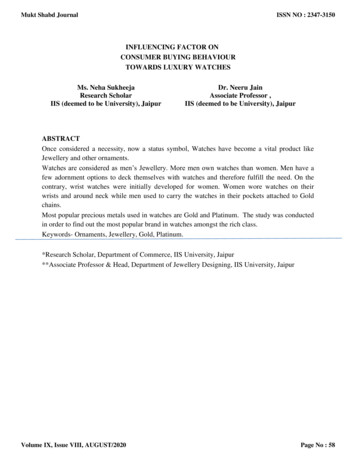
Transcription
INTRODUCTION TOTHE FIVE FACTOR MODEL ANDTHE WORKPLACE BIG FIVE PROFILE
INTRODUCTIONAt Paradigm Personality Labs, we believe understanding people is the key to unlockingbusiness success. The WorkPlace Big Five Profile , our premiere personality assessment, iswidely leveraged for human capital performance on nearly every continent.From global corporations to private consulting firms, the WorkPlace Big Five Profile offersin-depth personality insights that help people thrive in any organization.Referred to as the gold standard of personality measurement by psychologists andresearchers, the Five Factor Model (FFM) is the core of the WorkPlace Big Five Profile .This model defines personality through five distinct dimensions, and has been heavilyresearched and validated over time. A pure FFM tool, our assessment is one of the mostpsychometrically valid and reliable assessments in the industry. It is appropriate for allHuman Resources and Organizational Development applications.
In this Introduction, you will learn about:The Five Factor ModelThe “Big Five” personality dimensionsPopular applications of the WorkPlace Big Five Profile We hope this document provides you with a stronger understanding of theunderpinnings of the WorkPlace Big Five Profile , and has you ready to unlockbusiness success through your people.
THE FIVE-FACTOR MODEL“There are a variety of different perspectives in the fieldof personality However, the most commonly used andaccepted is the Five-Factor model.”– Piers Steel, Joseph Schmidt, & Jonas Shultz (2008)
FIVE FACTOR MODELINTRODUCTIONThe terms Big Five and Five-FactorModel are interchangeable. Thisempirically-based model providesresearchers with common languageto identify and describe the individualtraits that determine human behavior.Psychologists and personalityresearchers are using it as theprimary means of understanding andinterpreting personality.
Language as the DifferentiatorPersonality theories, or models, aremetaphors for describing somethingnearly indescribable -- the humanpersonality. Some metaphors arevaguer than others – for example,a PET brain scan is less vague thana pencil and paper test. Through thislogic, the study of personality hasbeen one of minimizing vagueness.It is from language itself and nottheories, that we extract the sourcemetaphor for describingpersonality.
Key Components of the Five-Factor ModelPersonality has 5 dimensions Scores on dimensionsPersonality is best described by individual traits rather than typegroupings. Strength of individual scores indicates personality preferences.People scoring in the midrange prefer a balance of the twoextremes for that trait.Each of the 5 dimensions, or “traits” reflects these physiologicalactivity of an underlying arousal system. For each behavioral arousalsystem, a unique type of stimulus triggers the arousal system into anew, different, or increased action.
Timeline of Five Factor Model DevelopmentThe Five Factor Model evolved over close to a century. Because it is anempirical model, wide-scale validation of the model was not possibleuntil the advent and availability of computers. The timeline belowtraces the evolution.Warren Miller, at the University ofSir Francis Galtonproposed an idea of alexical hypothesis- thatlanguage descriptorscould provide input for aframework for personality.Cattell reduced theseterms to 171 by eliminatingsynonyms and discovered 16clusters of personality traits.Michigan, learned of Tupesand Christal’s work and replicatedthe study and confirmed thefive-factor structure for traittaxonomy. These five factors arewhat we now know today as theFive Factor Model (or Big Five).194618841936Allport and Odertexplored this hypothesisand found 4,504 descriptivepersonality terms in themost comprehensive Englishdictionary at the time.The FFM is used as acommon language, humandevelopment and researchtool in business andacademic applications.Businesses apply the modelto best align leaders, teamsand employees withtheir roles andwith businessobjectives.196319541961These studies propelledAir Force personnelresearchers Tupes & Christalto conduct exhaustive computer-harnessed lexical studies,establishing the five factorswe know today. Unfortunately,their work was published in anobscure Air Force publication.Today1980’sWidely accessiblecomputing allowedpersonality researchers toexhaustively explore themodel.
Explosion in FFM Research and ApplicationOver the past 3 decades there has been exponential growth inthe research and application focused on the Five-Factor Model ofPersonality. A sampling of applications and topics includes:Uncovering physiological basis of traitsCorrelating traits to effective leadershipBig Five Traits as the basis for estimating person-environment fitThe Big Five as a universal language for describing individualdifferences (cross-cultural acceptance)The Big Five as the new basis of consumer behaviorThe Big Five as the basis of learning design (classroom, coaching,teambuilding, relationships, etc.)
The WorkPlace Big Five DimensionsThe WorkPlace Big Five Profile measures the five dimensions of the FFM and appliesthem to the workplace. We call these five dimensions Super Traits. Each Super Trait is muchlike a container, holding multiple Subtraits that define the Super Trait.SUPER TRAITSNeed ExtraversionOriginality(C)Each of the Super Traits, including their respective Subtraits, are described in detail on the following pages.
NNeed For Stability (N)Need for Stability (N) refers to the how a person responds to stress.More resilient persons tend to handle stressful workplace situations ina calm, steady, and secure way. More reactive persons tend to respondin an alert, concerned, attentive, or excitable way, thus creating theopportunity to experience more workplace stress than others.Biological Basis: The arousal system involved with Need for Stability(N) is the autonomic nervous system. The stimulus that triggers it is astressor, which elicits the general adaptation syndrome, better knownas the fight-or-flight response.
Resilient (N-)On the low end of the continuum are the Resilients (N-). Resilients tend to be more calmand rational at work than most people. They often appear impervious to stressors. At times,Resilients may be seen by others as not taking stressors, or situations, seriously. In reality,these individuals simply approach stressors from a logical stance rather than an emotionalone. This approach is very conducive for success in roles such as management, plane pilot,and medical surgeon.Responsive (N )Along the Need for Stability continuum from reactive to resilient is the mid-range of whatwe call Responsives (N ), who are a mixture of qualities characteristic of resilients andreactives. Responsives are more able to turn behaviors from both extremes on and off,calling on what seems appropriate to the situation. Responsives, however, are not typicallyable to maintain the calmness of a resilient for as long a period of time, nor is a responsivetypically able to maintain the nervous edge of alertness of a reactive (as, for example, wouldbe typical of a customer service agent).Reactive (N )On the high end of the need for stability continuum, we have the Reactives (N ), whoexperience more negative emotions than most people, generally reporting lower levelsof life satisfaction. That is not meant to place a value judgment on Reactives, however, asthe susceptibility to the need for stability in the workplace provides the basis for shapingextremely important roles in our society such as social scientists, customer serviceprofessionals, and academicians. However, extreme reactivity (high need for stability) caninterfere with the performance of many jobs, such as pilots and surgeons.N
NThe four main correlated traits which comprise the Need forStability “bucket” are listed and defined in the following table:SubtraitsResilient (N-)Responsive (N )Reactive (N )WorryAt ease most of thetimeSome concern fromtime to timeFrequently worriesIntensityUsually CalmOccasionally heatedQuicker temperInterpretationMore optimisticRealistic explanationsLess optimisticRebound TimeRapid rebound timeModerate reboundtimeLonger rebound time
EEXTRAVERSION (E)Extraversion refers to the degree to which a person can toleratesensory stimulation, from both people and situations. Those who scorehigh on extraversion prefer being around other people and involved inmany activities. Low extraversion is characterized by a preference towork alone and is typically described as serious, skeptical, quiet, and aprivate person.Biological Basis: The arousal system for Extraversion (E) is the somaticnervous system. The stimulus that triggers this system is sensation,that is the five senses. A person’s E score is an estimate of that point atwhich his or her somatic nervous system becomes saturated.
EIntrovert (E-)On the low end of the spectrum are the Introverts (E-). Introverts tend to be moreindependent, reserved, steady, and comfortable with being alone than most people. Thisintroverted profile is the basis of varied and important social roles such as productionmanagers and the harder physical and natural sciences.Ambivert (E )In between these two extremes are the Ambiverts (E ), who are able to move comfortablyfrom outgoing social situations to the isolation of working alone. The stereotypical ambivertis the player-coach, who moves upon demand from the leadership demands of coach tothe personal production demands of the player.Extravert (E )On the high end of the spectrum are the Extraverts (E ). Extraverts tend to exert moreleadership, be more physically and verbally active, and be more friendly and outgoingaround others than most people. This extraverted profile is the foundation of manyimportant social roles, from sales, to politics, to the arts and the softer social sciences.
The six personality traits which comprise Extraversion aredefined in the following table:SubtraitsIntrovert (E-)Ambivert (E )Extravert (E )WarmthHolds down positivefeelingsDemonstrates somepositive feelingsShows a lot ofpositive feelingsSociabilityPrefers working aloneOccasionally seeksout othersPrefers working withothersActivity ModePrefers being still orin one placeMaintains a moderateactivity levelPrefers to bephysically activeTaking ChargePrefers beingindependent ofothersAccepts someresponsibility ofothersEnjoys leading othersTrust of OthersSkeptical of othersSomewhat trustsothersReadily trusts othersTactTends to speak moredirectlySome care inselecting wordsCarefully selectswordsE
OORIGINALITY (O)Originality (O) refers to how open we are to new experiences and waysof doing things. People high in Originality (O ) usually have a varietyof interests, are drawn to cutting edge technology, and like strategicideas. Those lower in Originality (O-) tend to possess a more tacticalmindset; they are usually experts in a specific area, possessing a downto-earth view of the present.Biological Basis: The arousal system that provides for the basis of theOriginality (O) set of behaviors is a combination of the dopaminergicsystem and the general state of arousal of the cerebral cortex.Dopamine is proving to be the “creativity” chemical and each personhas a natural set point.
OPreservers (O-)On the low end of the Originality spectrum are Preservers (O-). The Preserver generallyholds narrower interests, is perceived as more conventional, and is more comfortable withthe familiar. The preserver profile is the basis for such important social roles as financialmanagers, performers, project managers, and applied scientists.Moderates (O )In the middle of the continuum are the Moderates (O ). The Moderate can explore thenovel with interest when necessary, but too much would be tiresome. On the other hand,the moderate can focus on the familiar for extended periods of time, but eventually woulddevelop a hunger for novelty.Explorers (O )High scorers in Originality are the Explorers (O ). Explorers have broader interests, afascination with novelty and innovation, and reports more introspection and reflectionthan the average individual. Explorers are not unprincipled, but they tend to be open toconsidering new approaches. The Explorer profile forms the basis for such important socialroles as entrepreneurs, architects, change agents, artists, and theoretical scientists (socialand physical).
OThe four personality traits which comprise Originality are defined in thetable below:SubtraitsPreserver (O-)Moderate (O )Explorer (O )ImaginationImplements plansCreates andimplements equallyCreates new plansand ideasComplexityPrefers simplicityBalances simple andcomplexSeeks complexityChangeWants to maintainexisting methodsSomewhat accepting Accepting of changesof changesand innovationsScopeAttentive to detailsAttends to details ifneededPrefers broad viewand resists details
AACCOMMODATION (A)Accommodation (A) describes the degree to which we defer to others.For example, individuals high in Accommodation (A ) tend to relate toothers by being tolerant, agreeable and accepting. On the other hand,individuals low in Accommodation (A-) tend to relate to others by beingtough, persistent, and competitive. Low scorers on A may come acrossto others as hostile, rude, self-centered, and not a team player, whilehigh A individuals may be perceived as easily walked over and too “gowith the flow”.Biological Basis: The arousal system that governs the Accommodation(A) set of behaviors consists of the ratio of sex hormones (whether inmales and females), along with the serotonergic system. The stimulusthat triggers this system into action is the dominance challenge, withserotonin levels affecting the trigger point.
AChallenger (A-)At the low end of the continuum are the Challengers (A-). These individuals are morefocused on their personal norms and needs rather than the needs of the group. TheCha
researchers, the Five Factor Model (FFM) is the core of the WorkPlace Big Five Profile . This model defines personality through five distinct dimensions, and has been heavily researched and validated over time. A pure FFM tool, our assessment is one of the most psychometrically valid and reliable assessments in the industry. It is appropriate for all
